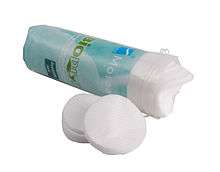Cotton pad


Cotton pads are pads made of cotton which are used for medical or cosmetic purposes.[1] For medical purposes, cotton pads are used to stop or prevent bleeding from minor punctures such as injections or venipuncture.[2] They may be secured in place with tape. Cotton pads are also used in the application and the removal of makeup.[1] Cotton pads are soft enough that they can be used to clean babies.[1] Cotton balls have much of the same applications as cotton pads, and can be used interchangeably.
Despite their name, most modern cotton balls and pads are not made out of cotton at all but are instead made out of cheaper, bleached synthetic fibers such as polyester[3] and nylon.[4] In the United States, these products are frequently prominently labeled as "cotton balls" because non-woven products (of which disposable wipes, diapers and tampons are other examples) are excluded from the Federal Trade Commission's stringent labeling requirements for textile products (15 U.S.C. § 70j).[5][6]
The specific phobia of cotton balls has been reported, buts its prevalence is unknown.[7]
History
Use of cotton for sanitary purposes likely dates back to its domestication. There is evidence that toilet paper, made in part of cotton and/or other plant fibers such as hemp,[8][9] was used at least as early as 589 AD in China.[10][lower-alpha 1] Cotton balls have been used for applying gold leaf since at least as far back as 1801. An artists' manual from that year recommends using a "squirrel's tail, or cotton ball" to press the gold leaf into place.[11] There is some evidence that they were being mass produced as far back as 1816, namely an advertisement taken out of the New York Evening Post by Palmer, Nichols & Co. for many different kinds of fabric and products made of cotton which lists "Cotton Balls" as an item for sale.[12] In 1891 The Laredo Times ran a story about women who put cotton balls in their cheeks to make themselves appear less thin.[13] An 1898 patent by Jerome B. Dillon for a new type of umbilical bandage used an "antiseptic, absorbent cotton pad" to carry out its function.[14]
In 1937, Joseph A. Voss invented a machine which unraveled rolls of cotton and cut them at a fixed interval into cotton pads,[15] starting the widespread consumption of cotton balls and pads. Companies producing cotton balls took out ads in newspapers as early as 1948 to promote their uses to the public.[1] In 1965, it was reported in the Opelousas Daily World that the sanitary cotton industry in the United States was worth $60 million ($460.4 million in 2016 CPI-adjusted dollars).[16] Around this time, there was industry concern that sanitary products using nylon, labeled as cotton balls, were going to crowd out cotton balls actually containing cotton, harming cotton-exporting regions.[16] In 1986, Johnson & Johnson, a manufacturer of cotton balls, published advertisements stating that "doctors advise" cotton balls over "synthetic puffs".[4] By 2013 however, most consumer cotton balls and pads outside of specifically labeled "100% Cotton" organic brands contained mostly polyester and only nominal amounts of cotton.[3]
See also
References
- 1 2 3 4 "Uses of Cotton Balls Announced". Newspapers.com. Lansing, MI: Lansing State Journal. 1948-04-23. p. 19. Retrieved 2016-11-29 – via Newspapers.com.
- ↑ Best practices for injection. World Health Organization, National Center for Biotechnology Information. 2010-03-01.
Apply a 60–70% alcohol-based solution (isopropyl alcohol or ethanol) on a single-use swab or cotton-wool ball.
- 1 2 Neporent, Liz (21 November 2013). "Dangerous Diet Trend: The Cotton Ball Diet". ABC News. Retrieved 2016-11-30.
- 1 2 Cardi, MD, Louis P. (1986-04-03). "Cotton Balls or Synthetic Puffs? It Makes a Difference.". St. Louis Post-Dispatch. p. 66. Retrieved 2016-11-29 – via Newspapers.com.
- ↑ "Threading Your Way Through the Labeling Requirements Under the Textile and Wool Acts | Federal Trade Commission". www.ftc.gov. Retrieved 2016-11-30.
- ↑ "When It Comes To Bleached Cotton, Labels Can Be Misleading". Cotton Library. Barnhardt Natural Products Group. 2014-05-27. Retrieved 2016-11-30.
- ↑ Friedman, E. Not Just Afraid of the Dark. abcnews.com. August 13, 2008.
- ↑ "Toilet Paper History & Timeline". toiletpaperworld.com. Consumers Interstate Corporation. Retrieved 2016-11-29.
- ↑ Dr. Ray, Keith. "Chinese Inventions". SACU.org. The Society for Anglo-Chinese Understanding. Retrieved 2016-11-19.
Chai Lum based his paper on a variety of fibrous materials, including rope pieces, old fishing nets, rags, bamboo fibres and tree bark.
- ↑ Needham, Joseph (1986). Science and Civilization in China: Volume 5, Chemistry and Chemical Technology, Part 1, Paper and Printing. Taipei: Caves Books, Ltd.
- ↑ The Artist's Assistant, Swinnery & Hawkins, Birmingham, 1801; page 260.
- ↑ "DRY GOODS (advertisement)". New York Evening Post. 1816-10-03. Retrieved 2016-11-29 – via Newspapers.com.
- ↑ "Here's a New Device". The Laredo Times. 1891-12-10. p. 2. Retrieved 2016-11-29 – via Newspapers.com.
- ↑ Dillon, B. (8 Nov 1898), US Patent #613,761, retrieved 2016-11-29
- ↑ Voss, Joseph A. (Nov 1, 1938), Cotton cutting machine, retrieved 2016-11-29
- 1 2 Brown, Evrard (1965-08-11). "Nylon Balls for Cotton". Daily World (Opelousas). Retrieved 2016-11-29 – via Newspapers.com.
Notes
- ↑ See also: Toilet paper §§ History